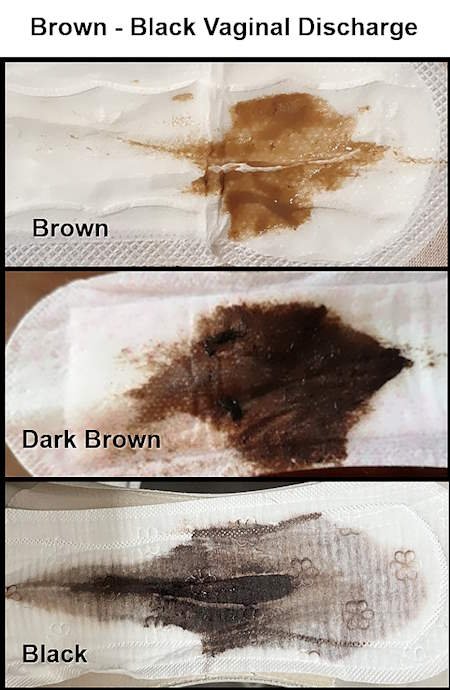Black Vaginal Discharge: Causes & When to See a Doctor
Noticing black vaginal discharge can be unsettling, but it’s not always a sign of something serious. In many cases, it’s a natural part of your body’s menstrual cycle. The most common cause of black discharge is the oxidation of blood. When blood is exposed to oxygen, it changes from bright red to brown or even black. However, there are times when dark brown or black discharge may indicate an underlying issue, such as an infection, a forgotten object, or, in rare cases, a more serious condition like cervical cancer.
In this article, we’ll explore the common causes of black vaginal discharge, when it’s considered normal, and when you should seek medical attention.
Key Takeaways
- Black discharge is often just blood that has been exposed to oxygen, causing it to darken.
- It can be normal if it occurs at the beginning or end of your period.
- If black discharge is accompanied by symptoms like a foul odor, pain, or fever, it may indicate an underlying issue that requires medical attention.
- Common causes of black discharge include forgotten objects, sexually transmitted infections (STIs), pelvic inflammatory disease (PID), implantation bleeding, miscarriage, and, rarely, cervical cancer.
- Maintaining good genital hygiene can help reduce the risk of infections.
What Does Black Discharge Mean?
When we think of menstrual blood, the image that typically comes to mind is a bright red flow. However, menstrual blood can vary in color, and one of the more concerning variations for many is black discharge. This change in color occurs because menstrual blood darkens as it is exposed to oxygen over time, a process known as oxidation. The longer the blood remains in the uterus before being expelled, the more it oxidizes, leading to darker shades ranging from brown to black. In some cases, the discharge may appear so dark that it resembles coffee grounds.

When Is Black Discharge Normal?
- At the beginning of your period: Menstrual cycles often start with bright red blood as the uterine lining sheds quickly. However, if the flow is slow, the blood may oxidize before leaving the body, resulting in dark brown or black discharge.
- At the end of your period: As your period winds down, the blood flow slows, giving it more time to oxidize. This can also lead to black or dark brown discharge.
When Is Black Discharge Abnormal?
Black discharge is considered abnormal if it occurs at times other than the beginning or end of your period, or if it’s accompanied by symptoms like pain, fever, or a foul odor. In such cases, it’s important to consult a healthcare provider.
Keeping a symptom tracker can help you monitor any unusual changes in your cycle. This way, you can provide your doctor with detailed information about when the black discharge occurs and any associated symptoms.
Common Causes of Black Discharge
Besides being a normal part of your menstrual cycle, black discharge can also be caused by other factors. Let’s explore some of the most common reasons.
Forgotten or Stuck Objects
Have you ever forgotten about a tampon or other object in your vagina? You’re not alone. Sometimes, dark brown or black discharge can serve as a reminder that something has been left behind.
Symptoms associated with a forgotten or stuck object include:
- Foul-smelling discharge
- Vaginal itching or discomfort
- Vaginal rash
- Fever
It’s important to note that objects cannot get “lost” in the vagina, as the cervical opening is too small. However, they can become stuck, leading to irritation and infection.
One of the most common forgotten objects is a tampon. If your period is light, it’s easy to forget you’ve inserted one. Leaving a tampon in for too long can lead to infection and, in rare cases, toxic shock syndrome (TSS). TSS affects approximately 0.8 to 3.4 women per 100,000 in the U.S.
Symptoms of TSS include:
- Fever
- Sunburn-like rash
- Low blood pressure
- Nausea and vomiting
Other items that may get stuck or forgotten include sex toys or barrier contraceptive devices like diaphragms, female condoms, caps, or sponges. If you suspect you have something stuck in your vagina, seek medical attention immediately.
Sexually Transmitted Infections (STIs)
STIs such as chlamydia and gonorrhea can cause inflammation, pain, and abnormal discharge, including black or dark brown discharge.
Other symptoms of STIs may include:
- Foul-smelling discharge
- Vaginal bleeding during or after sex
- Vaginal itching or irritation
- Pain in the lower abdomen
STIs require prompt treatment with antibiotics. If left untreated, they can lead to more serious conditions like pelvic inflammatory disease (PID). For More information please see “Sexually Transmitted Diseases (STDs) Symptoms, Causes, Types and Precautions“.
Pelvic Inflammatory Disease (PID)
Pelvic inflammatory disease (PID) is an infection of the female reproductive organs, including the uterus, fallopian tubes, or ovaries. This condition can cause a range of symptoms, such as:
- Pelvic pain
- Fever
- Abnormal vaginal discharge, including brown or black discharge
If you suspect you have PID, it’s important to seek medical attention. Your doctor can diagnose the condition through a physical exam and blood tests to identify specific organisms.
PID is not an infection to ignore. If left untreated, it can lead to serious complications, including fertility issues, pain during sex, abscesses, scarring of the fallopian tubes, and an increased risk of ectopic pregnancy.
Implantation Bleeding
Implantation bleeding occurs when a fertilized egg attaches itself to the uterine lining, causing light vaginal bleeding or spotting. This type of bleeding is not experienced by everyone, but research shows it occurs in 15-25% of pregnancies.
When implantation bleeding happens, the blood may take time to exit the body, which can cause it to appear dark brown or black. This is typically a normal part of early pregnancy and not a cause for concern. For more details please see “Implantation Bleeding vs. Period: Signs, Symptoms, and Key Differences“.
Missed Miscarriage
Not all miscarriages are obvious. A missed miscarriage, also known as a silent miscarriage, occurs when the embryo stops developing, but the body does not immediately expel it. This type of miscarriage typically happens between weeks five and 12 of pregnancy.
Many women with a missed miscarriage may not experience noticeable symptoms. However, some may notice:
- Brown or black discharge
- Mild cramping
- A decrease in pregnancy symptoms, such as breast tenderness
- Feelings of anxiety or an unexplainable sense that something is wrong
If you suspect a missed miscarriage, it’s important to consult your healthcare provider for evaluation and support. For more information please see “Miscarriage: Symptoms, Causes, Risks, Treatment & Prevention“.
Lochia
Lochia is the term used to describe vaginal discharge that occurs after childbirth. This discharge can last anywhere from four to six weeks and may vary in color from bright red to dark brown or black.
As the flow slows down, the discharge may appear darker. Over time, the color should shift to a yellowish-white before eventually stopping altogether. Lochia is a normal part of the postpartum healing process.
Cervical Cancer
While rare, black discharge can sometimes be a sign of cervical cancer. Approximately 0.0076% of women are diagnosed with cervical cancer each year.
Other symptoms of cervical cancer may include:
- Bleeding during or after sex
- Bleeding between periods
- Pain during urination or bowel movements
- Foul-smelling discharge
- Pelvic pain
If you experience any of these symptoms, it’s important to see a doctor for further evaluation and testing.
When to See a Doctor for Black Discharge
Whether you should seek medical advice for black discharge depends on the underlying cause. If the discharge occurs around the time of your period or is related to pregnancy, it may resolve on its own. However, if you experience additional symptoms, it’s best to consult a healthcare provider.
These symptoms include:
- Foul-smelling discharge
- Vaginal itching or irritation
- Chronic pelvic pain
- Fever
- Pain during sex
- Changes in your menstrual cycle
Your doctor can help determine the cause of the black discharge and recommend an appropriate treatment plan.
How to Treat Black Discharge
There is no universal treatment for black discharge, as the approach depends on the underlying cause. Below is a breakdown of common causes and their corresponding treatments:
| Reason | Treatment |
|---|---|
| Foreign object | Remove the object and, if necessary, prescribe antibiotics to treat any infection. |
| STI | Antibiotics are typically used to treat sexually transmitted infections. |
| PID | Antibiotics are the primary treatment, but severe cases may require surgery. |
| Missed miscarriage | Surgical evacuation may be necessary to remove the remaining tissue. |
| Cervical cancer | Treatment options include chemotherapy, radiation, or surgery, depending on the stage of cancer. |
Tips for Vaginal Health
Maintaining vaginal health is crucial, whether you’re experiencing black discharge or not. Here are some best practices to keep your vaginal area healthy:
- Wear cotton underwear: Cotton allows for better airflow and reduces the risk of infection. Avoid materials like silk, lace, or satin, which can trap heat and moisture.
- Wash the genital area properly: Use mild, unscented soap to avoid disrupting the vagina’s natural pH balance.
- Avoid douching: Douching can remove good bacteria and increase the risk of infections, PID, bacterial vaginosis (BV), and even pregnancy complications.
- Skip perfumed products: Avoid using scented soaps, lotions, or sprays in the vaginal area, as they can upset the pH balance.
- Use condoms: Condoms help prevent sexually transmitted infections (STIs).
- Keep track of tampons and other objects: Regularly check to ensure you haven’t left any objects, such as tampons or contraceptive devices, in your vagina.
While black discharge can be a normal occurrence, it’s important to pay attention to any additional symptoms. If you experience discomfort, pain, or other unusual signs, consult a healthcare provider.
Final Thoughts
Black vaginal discharge is often a normal part of the menstrual cycle, caused by the buildup of blood and tissue in the uterus. When blood takes longer to exit the body, it oxidizes and turns brown or black. Other potential causes include infections, implantation bleeding, or miscarriage.
If you’re concerned about black discharge or experience symptoms like pain, irritation, or fever, it’s important to speak with your doctor for proper evaluation and treatment.
Frequently Asked Questions (FAQs)
What does black discharge with no period mean?
Black discharge without a period can occur when the uterus takes longer to clear menstrual flow. While this is usually not a cause for concern, consult a doctor if it’s accompanied by pain, irritation, or discomfort.
Is black discharge a sign of pregnancy?
Yes, black discharge can be an early sign of pregnancy. It may result from implantation bleeding, which causes light spotting. If you suspect you’re pregnant, take a pregnancy test and consult your doctor.
What does black period blood mean?
Black period blood is normal at the beginning or end of your period. It indicates that the blood has taken longer to exit the body and has oxidized. However, if you experience other symptoms alongside black discharge, seek medical advice.
What does black discharge after a period mean?
Black discharge after a period is often just old blood that has taken longer to exit the uterus. This is usually normal, especially if the flow was light at the end of your cycle. However, if the discharge is accompanied by pain, a foul odor, or other unusual symptoms, it’s best to consult a doctor.
What does black discharge before a period mean?
Black discharge before a period can occur due to the slow shedding of the uterine lining, which allows blood to oxidize and darken. This is typically normal, but if it happens frequently or is accompanied by other symptoms, it’s worth discussing with your healthcare provider.
Why is my discharge black 2 weeks after my period?
Black discharge two weeks after your period could be due to ovulation spotting, hormonal fluctuations, or leftover menstrual blood. However, if it’s persistent or accompanied by pain, itching, or a foul smell, it may indicate an underlying issue like an infection or hormonal imbalance. Consult your doctor for further evaluation.
What does blackish-brownish discharge mean?
Blackish-brownish discharge is usually old blood that has oxidized. It can occur at the beginning or end of your period, after childbirth, or due to hormonal changes. If the discharge is persistent or accompanied by other symptoms, it’s important to seek medical advice.
Could black discharge instead of a period mean I’m pregnant?
Yes, black discharge instead of a period could be a sign of pregnancy, particularly if it’s due to implantation bleeding. This occurs when a fertilized egg attaches to the uterine lining, causing light spotting. If you suspect pregnancy, take a test and consult your doctor.
What does black discharge after a LEEP procedure mean?
Black discharge after a LEEP (Loop Electrosurgical Excision Procedure) is common as the cervix heals. It’s usually old blood mixed with cervical tissue. However, if the discharge is excessive, has a foul odor, or is accompanied by severe pain or fever, contact your healthcare provider immediately.










